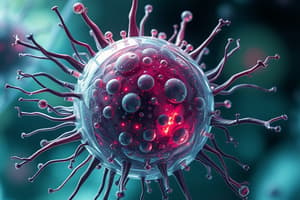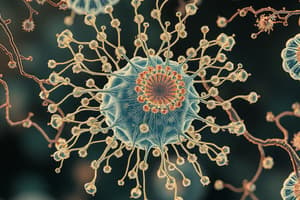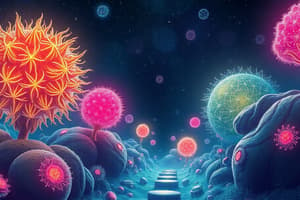Podcast
Questions and Answers
What is regarded as the most basic unit of life?
What is regarded as the most basic unit of life?
- Cell (correct)
- Tissue
- Organism
- Organ
Which of the following is an exception to the cell theory?
Which of the following is an exception to the cell theory?
- Bacteria (correct)
- Red blood cells
- Fungi
- Nerve cells
What do all living cells have in common?
What do all living cells have in common?
- They possess a cell membrane. (correct)
- They can conduct photosynthesis.
- They are large enough to be seen without a microscope.
- They contain a well-defined nucleus.
How do viruses differ from living cells according to the cell theory?
How do viruses differ from living cells according to the cell theory?
Which cellular structure is found in the vast majority of living cells?
Which cellular structure is found in the vast majority of living cells?
What is the primary function of the nuclear lamina?
What is the primary function of the nuclear lamina?
What is a defining characteristic of coenocytic hyphae?
What is a defining characteristic of coenocytic hyphae?
What is contained within the granular regions of the nucleolus?
What is contained within the granular regions of the nucleolus?
What is the typical size range for most cells?
What is the typical size range for most cells?
Which of the following statements about chromatin and chromosomes is correct?
Which of the following statements about chromatin and chromosomes is correct?
Why is the cell principle considered better than cell theory?
Why is the cell principle considered better than cell theory?
How does the nucleus regulate molecular flow?
How does the nucleus regulate molecular flow?
What is the constricted region of linear chromosomes known as?
What is the constricted region of linear chromosomes known as?
What is one of the primary functions of cytoplasm?
What is one of the primary functions of cytoplasm?
Which of the following describes lipid droplets?
Which of the following describes lipid droplets?
What is the primary role of telomeres?
What is the primary role of telomeres?
How many chromosomes do humans have in their diploid cells?
How many chromosomes do humans have in their diploid cells?
What is a characteristic of cytoplasmic streaming?
What is a characteristic of cytoplasmic streaming?
What primarily fills the nucleoplasm?
What primarily fills the nucleoplasm?
Which structure is NOT found in the nucleus?
Which structure is NOT found in the nucleus?
What comprises the structure of ribosomes?
What comprises the structure of ribosomes?
At which location does DNA replication start on a chromosome?
At which location does DNA replication start on a chromosome?
Which of the following statements about chromosome number is correct?
Which of the following statements about chromosome number is correct?
Which component of ribosomes is typically larger?
Which component of ribosomes is typically larger?
What is a key characteristic of multicellular organisms that distinguishes them from unicellular organisms?
What is a key characteristic of multicellular organisms that distinguishes them from unicellular organisms?
Which of the following statements correctly describes unicellular organisms?
Which of the following statements correctly describes unicellular organisms?
What main factor limits the size of unicellular organisms?
What main factor limits the size of unicellular organisms?
Which feature primarily differentiates the lifespan of unicellular organisms from multicellular organisms?
Which feature primarily differentiates the lifespan of unicellular organisms from multicellular organisms?
Which organisms are classified as eukaryotic?
Which organisms are classified as eukaryotic?
What is the primary role of specialized cells in multicellular organisms?
What is the primary role of specialized cells in multicellular organisms?
What type of organisms primarily exhibit a low level of operational efficiency?
What type of organisms primarily exhibit a low level of operational efficiency?
Which statement accurately reflects the injury response of multicellular organisms?
Which statement accurately reflects the injury response of multicellular organisms?
What aspect of the cell theory was formulated by Matthias Schleiden and Theodor Schwann?
What aspect of the cell theory was formulated by Matthias Schleiden and Theodor Schwann?
Which organism is an example of a unicellular plant?
Which organism is an example of a unicellular plant?
What type of ribosomes are primarily found in eukaryotic cells' cytosol?
What type of ribosomes are primarily found in eukaryotic cells' cytosol?
Which statement about ribosomes is accurate?
Which statement about ribosomes is accurate?
What is the primary function of the Rough Endoplasmic Reticulum (RER)?
What is the primary function of the Rough Endoplasmic Reticulum (RER)?
Which form of protein translocation involves moving proteins through nuclear pores?
Which form of protein translocation involves moving proteins through nuclear pores?
What describes organellar ribosomes?
What describes organellar ribosomes?
What process is primarily managed by the Endoplasmic Reticulum?
What process is primarily managed by the Endoplasmic Reticulum?
Which characteristic distinguishes Smooth Endoplasmic Reticulum (SER) from Rough Endoplasmic Reticulum (RER)?
Which characteristic distinguishes Smooth Endoplasmic Reticulum (SER) from Rough Endoplasmic Reticulum (RER)?
Which of the following is NOT true about ribosome biogenesis in eukaryotes?
Which of the following is NOT true about ribosome biogenesis in eukaryotes?
Study Notes
Unicellular Organisms
- Single-celled organisms and the most primitive form of life, possibly dating back 3.8 billion years.
- Main groups include bacteria, archaea, protozoa, algae, and fungi.
- Categorized as prokaryotic (no nucleus) and eukaryotic (with nucleus) based on cellular organization.
- Mostly microscopically small, classified as microorganisms.
- Examples include:
- Bacteria: Escherichia coli, Mycobacteria
- Protozoans: Amoeba, Paramecium
- Algae: Chlorella, Chlamydomonas, Diatoms
- Fungi: Yeast
Multicellular Organisms
- Composed of many specialized cells for various functions, increasing complexity.
- Many bacteria species, such as Myxobacteria, can form multicellular structures.
- Most eukaryotic organisms are multicellular with developed body structures and specific organs.
- Examples of unicellular plants include Chlamydomonas and Chlorella; Acetabularia is a large unicellular green algae.
Differences Between Unicellular and Multicellular Organisms
- Body Structure: Unicellular has one cell; multicellular consists of numerous cells.
- Division of Labour: Unicellular may operate at cellular level, multicellular at organ/system levels.
- Operational Efficiency: Higher in multicellular organisms.
- Cell Specialization: Unicellular carries out all life processes; multicellular cells have specific functions.
- Cell Exposure: Unicellular cells are completely exposed; multicellular only outer cells face the environment.
- Injury or Death: Unicellular can survive some cell damage; multicellular can be affected by damage.
- Cell Size and Lifespan: Unicellular sized by surface area limits; multicellular can grow larger but often have shorter lifespans due to specialization.
- Regeneration: Regenerative capacity decreases with specialization in multicellular organisms.
Common Functions of Unicellular and Multicellular Organisms
- All organisms must uptake nutrients, excrete waste, respond to stimuli, and reproduce.
What is a Cell?
- Basic functional unit of all living organisms.
- Discovered by Robert Hooke in 1665.
- Self-replicating and responds to environmental changes.
- Known as the building block of life with cell biology as its study.
Cell Theory
- Formulated by Matthias Schleiden, Theodor Schwann, and Rudolf Virchow.
- Key principles:
- All living organisms consist of cells.
- The cell is the fundamental unit of life.
- Highlights the structural and functional unity across diverse life forms.
Exceptions to Cell Theory
- Viruses lack protoplasm, made of proteins and nucleic acids.
- Bacteria lack organized nuclei and associated structures; chromosomes are in direct contact with cytoplasm.
- Coenocytic fungi and some protists can be multinucleate.
Cellular Hierarchy
- Organism (e.g., Humans)
- Organ system (e.g., Respiratory system)
- Organ (e.g., Lung)
- Tissue (e.g., Epithelial tissue)
- Cell (e.g., Monocyte)
Diversity in Cell Size and Shape
- Most cells are microscopic, with significant variation.
- Typical cell sizes range from 5-15 micrometers; nerve cells can be up to 1-2 meters.
- Notable sizes: ostrich egg (175 mm), human cells (3-4 microns to 90-100 cm).
Chromatin and Chromosomes
- Chromatin: DNA and protein structure found in the nucleus of eukaryotic cells.
- Chromosomes: Highly condensed DNA converting chromatin into a compact form during cell division.
Functions of the Nucleus
- Governs cell function, regulates molecular flow, and facilitates DNA replication and ribosome production.
Cytoplasm
- Space between the cell membrane and nucleus where metabolism occurs.
- Functions include support, protection, storage, and transport.
Ribosomes
- Composed of RNA and proteins, crucial for protein synthesis.
- Types include:
- Cytosolic Ribosomes: Found in eukaryotic cell cytosol.
- Organellar Ribosomes: Smaller, located in mitochondria and chloroplasts.
Endoplasmic Reticulum (ER)
- Large organelle contiguous with the nuclear membrane.
- Types include:
- Rough ER: Studded with ribosomes, involved in protein synthesis.
- Smooth ER: Lacks ribosomes, site of lipid synthesis and detoxification.
- The ER processes instructions from the nucleus and is essential for product creation and secretion.
Studying That Suits You
Use AI to generate personalized quizzes and flashcards to suit your learning preferences.
Related Documents
Description
This quiz explores the fascinating world of unicellular and multicellular organisms. Learn about the various types of unicellular organisms, including bacteria, archaea, protozoa, algae, and fungi, and understand their significance in the biological hierarchy. Dive into the differences between prokaryotic and eukaryotic organisms.




